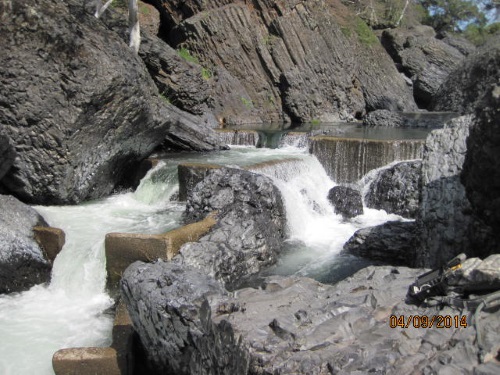Background

Big Chico Creek’s Iron Canyon fish ladder.
The Department of Fish and Wildlife (CDFW) has collected both adult and juvenile spring-run Chinook salmon monitoring data for many years. Juvenile emigrant data was collected from 1995-2003 using a rotary screw trap. Data indicated juvenile salmon are generally present from early December through mid-May. Peak migration for all years of trapping on BCC occurred in the first two weeks of March. Adult spring-run population estimates on Big Chico Creek date back to 1956 (CDFG 1998). Many of the early estimates were generated by observation at key holding pools. Beginning in 1989, snorkel surveys became the primary form of survey. The DFW planted hatchery origin spring-run in Big Chico Creek occasionally between 1959 and 1992. In the 1980’s, adult spring-run returns were extremely low and continued sporadic Feather River Hatchery plantings made assessing the status of the natural population difficult. Currently, it is difficult to determine whether the Big Chico Creek spring-run population is self-sustaining or supported by exchange of individuals from the larger Central Valley spring-run population. In 2006, 299 adult spring-run returned to Big Chico Creek. CDFW was able to collect 30 tissue samples from carcasses. Genetic data suggested eighteen of the samples were Butte Creek spring-run, two were Deer or Mill Creek spring-run, five were fall-run Chinook salmon, and five were unidentified Chinook salmon. Although not a comprehensive assessment of the run that year, it suggests that in some years the population in Big Chico Creek may be composed of salmon from multiple salmon runs and populations.